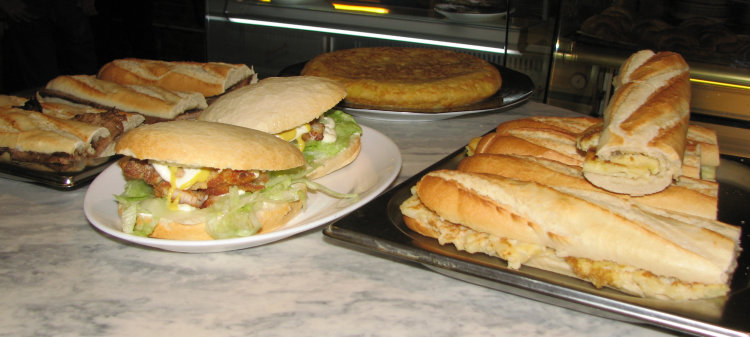Pan con pan, comida de tontos (bread with bread is food for idiots), but bread with something on top is a fast and filling meal in many countries of the world. Spain is no exception: the issue is how to navigate sandwich, bocata, montado and pulga to get what you want.
Here in España, what’s inside your sandwich depends at least partially on the sandwich style you choose. There seems to be a rough division between the classic Spanish sandwich styles (bocadillo, montado) and international or “modern” styles (sandwich, tosta). For example, Spanish classics like potato omelette, pork tenderloin and squid rings do not appear between slices of white loaf bread, only in bocadillos. Lettuce, asparagus and mayonnaise are rarely used in bocadillos but frequent in sandwiches, tostas and even pulgas. Tomato is more universal – frequent in sandwiches, not infrequent in bocadillos and montados; in Cataluña bocadillos are automatically served with tomato-rubbed bread (not sliced tomato) unless you specifically ask for plain bread.
So how to get your sandwich? Here’s a fast guide to some of Spain’s sandwich styles.
Sandwich: In a cafeteria or restaurant this is usually made with toasted white loaf bread, and usually with hot filling (grilled ham and cheese, bacon) except for vegetarian options or chicken, also with toasted bread but usually cold. This is a casual sit-down meal, usually eaten with a knife and fork, though it’s no longer odd to eat as finger food. Some places like Rodilla and Vienna Capellanes chains do cold sandwiches to go, often made with a mayo-based sandwich spread and sometimes with other kinds of loaf bread. Trivia: the phonetic or half-English spellings can be confusing: samwis, sanwhis, sandwish are all logical spellings in Spanish. And don’t forget bi-lingual slips: hay sandwiches means “there are sandwiches”, not sandwiches made of hay.
Bocadillo: A hearty sandwich on baguette bread. The bread is usually cold though what’s inside might be hot (sausage, pork tenderloin, fried squid rings). Finger food, easy to eat while standing at the bar or perched on a stool. Trivia: the slang word for bocadillo is bocata, usually indicating a larger-than-usual size. Oddest bocadillo filling ever seen: patatas bravas (fried potato chunks with hot sauce).
Montado, montadito: Usually but not always open face, a slice of cold baguette bread with something on top. Frequent for lomo (pork tenderloin). Montadito is the smaller version.
Tosta: Almost always open face, baguette bread or slice from a big round loaf, grilled so bread is at least warm if not toasted and what’s on top is warmed up.
Pulga: Small bocadillo, usually cold, often on softer dinner roll instead of a miniature baguette. Trivia: pulga means flea in Spanish, and the dinner rolls often used for these sandwiches are called medianoches (midnights).
And a few with-bread concoctions that are not quite sandwiches:
Empanada, empanadilla: Originally from Galicia in northwest Spain, Spanish empanadas are not the same as the Latin American version. This is kind of a cold, covered pizza with a tomato-onion filling with tuna fish or sausage; in Galicia there are many other kinds of filling. There are two kinds of crust, one a flaky pastry, and the other a hearty though not too-thick bread. Empanadas are big and often sold by slice or weight, empanadillas are individual portions. Good for takeaway, easy to eat on the street, good party food and an easy option for a light dinner.
Pincho: If you’d rather pass on the pan (bread) you can still get a fast and light meal: just go for a pincho, something with a bit of bread on the side. Most frequently seen for tortilla expañola (potato omelette), sausage or pincho moruno (skewer of meat).
*Desiree, Cafeteria in Tres Cantos (calle del Viento 7, near the train station). Friendliest people and best coffee in town! Excellent tomato toast for breakfast (insider tip: get “media”, the full size is too big for a normal person). Good carry-out, too. Why go to Tres Cantos if you don’t live or work there? It’s the beginning / end for some excellent hikes, and one of the stops on the yearly 100 kilometers in 24 hours challenge

